Top Rankings
Gorham Randolph Shelburne Cooperative School District ranks among the top 20% of public school district in New Hampshire for:
Category
Attribute
Student Attention
Lowest student:teacher ratio (Top 1%)
For the 2025 school year, there are 3 public schools serving 370 students in Gorham Randolph Shelburne Cooperative School District. This district's average testing ranking is 5/10, which is in the bottom 50% of public schools in New Hampshire.
Public Schools in Gorham Randolph Shelburne Cooperative School District have an average math proficiency score of 40% (versus the New Hampshire public school average of 41%), and reading proficiency score of 50% (versus the 51% statewide average).
Minority enrollment is 9% of the student body (majority Hispanic), which is less than the New Hampshire public school average of 18% (majority Hispanic).
Overview
This School District
This State (NH)
# Schools
3 Schools
508 Schools
# Students
370 Students
165,155 Students
# Teachers
40 Teachers
14,445 Teachers
Student : Teacher Ratio
9:1
9:1
District Rank
Gorham Randolph Shelburne Cooperative School District, which is ranked within the bottom 50% of all 189 school districts in New Hampshire (based off of combined math and reading proficiency testing data) for the 2021-2022 school year.
The school district's graduation rate of 90% has stayed relatively flat over five school years.
Overall District Rank
#111 out of 189 school districts
(Bottom 50%)
(Bottom 50%)
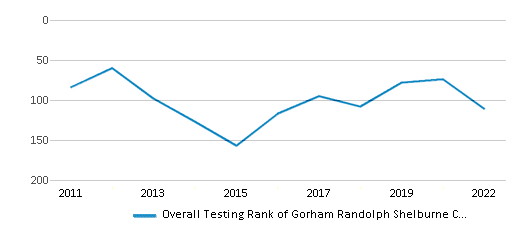
Math Test Scores (% Proficient)
41%
40%
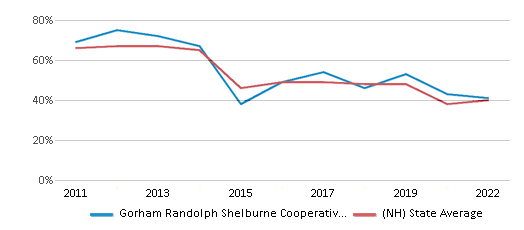
Reading/Language Arts Test Scores (% Proficient)
50%
51%
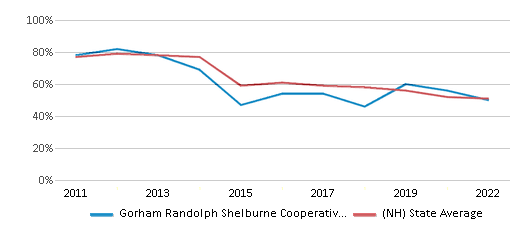
Science Test Scores (% Proficient)
35-39%
36%
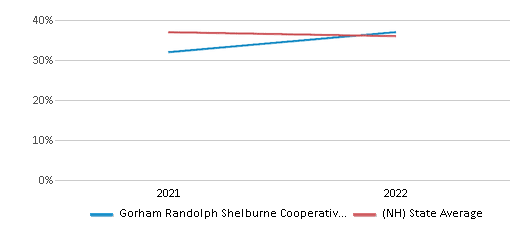
Graduation Rate
≥90%
88%
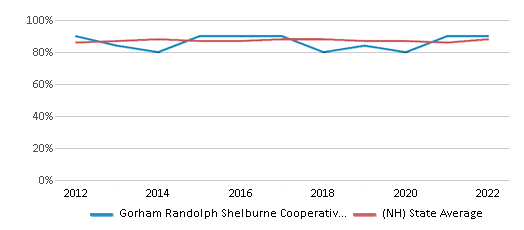
Students by Ethnicity:
Diversity Score
0.17
0.32
# American Indian Students
n/a
308 Students
% American Indian Students
n/a
n/a
# Asian Students
6 Students
4,993 Students
% Asian Students
2%
3%
# Hispanic Students
16 Students
12,212 Students
% Hispanic Students
4%
8%
# Black Students
2 Students
3,437 Students
% Black Students
n/a
2%
# White Students
336 Students
135,947 Students
% White Students
91%
82%
# Hawaiian Students
n/a
133 Students
% Hawaiian Students
n/a
n/a
# Two or more races Students
10 Students
8,195 Students
% of Two or more races Students
3%
5%
Students by Grade:
# Students in PK Grade:
-
4,442
# Students in K Grade:
19
10,942
# Students in 1st Grade:
25
11,733
# Students in 2nd Grade:
33
12,179
# Students in 3rd Grade:
20
12,078
# Students in 4th Grade:
28
12,182
# Students in 5th Grade:
22
12,522
# Students in 6th Grade:
28
11,957
# Students in 7th Grade:
29
12,326
# Students in 8th Grade:
27
12,086
# Students in 9th Grade:
40
13,698
# Students in 10th Grade:
35
13,269
# Students in 11th Grade:
34
13,028
# Students in 12th Grade:
30
12,713
# Ungraded Students:
-
-
District Revenue and Spending
The revenue/student of $22,816 is higher than the state median of $22,075. The school district revenue/student has stayed relatively flat over four school years.
The school district's spending/student of $24,503 is higher than the state median of $21,293. The school district spending/student has stayed relatively flat over four school years.
Total Revenue
$8 MM
$3,646 MM
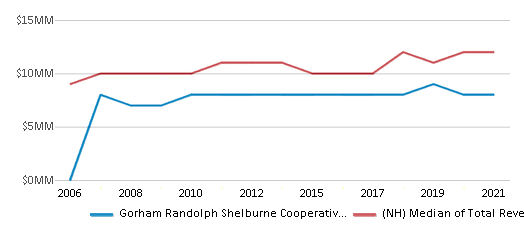
Spending
$9 MM
$3,517 MM
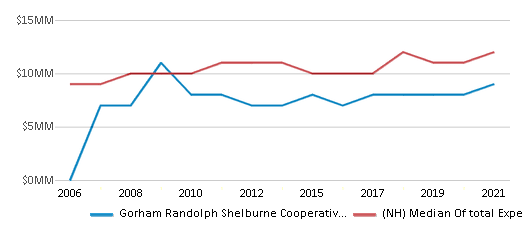
Revenue / Student
$22,816
$22,075
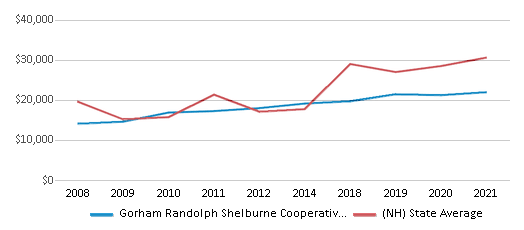
Spending / Student
$24,503
$21,293

Best Gorham Randolph Shelburne Cooperative School District Public Schools (2025)
School
(Math and Reading Proficiency)
(Math and Reading Proficiency)
Location
Grades
Students
Rank: #11.
Edward Fenn School
(Math: 50-54% | Reading: 55-59%)
Rank:
Rank:
8/
Top 30%10
169 Main St.
Gorham, NH 03581
(603) 466-3334
Gorham, NH 03581
(603) 466-3334
Grades: K-5
| 147 students
Rank: #22.
Gorham Middle School
(Math: 35-39% | Reading: 45-49%)
Rank:
Rank:
5/
Bottom 50%10
120 Main St.
Gorham, NH 03581
(603) 466-2776
Gorham, NH 03581
(603) 466-2776
Grades: 6-8
| 84 students
Rank: #33.
Gorham High School
(Math: 20-29% | Reading: 40-49%)
Rank:
Rank:
2/
Bottom 50%10
120 Main St.
Gorham, NH 03581
(603) 466-2776
Gorham, NH 03581
(603) 466-2776
Grades: 9-12
| 139 students
Frequently Asked Questions
How many schools belong to Gorham Randolph Shelburne Cooperative School District?
Gorham Randolph Shelburne Cooperative School District manages 3 public schools serving 370 students.
What is the rank of Gorham Randolph Shelburne Cooperative School District?
Gorham Randolph Shelburne Cooperative School District is ranked #104 out of 189 school districts in New Hampshire (bottom 50%) based off of combined math and reading proficiency testing data for the 2021-2022 school year. This district ranks in the top 20% of New Hampshire school districts for: Lowest student:teacher ratio (Top 1%)
What is the racial composition of students in Gorham Randolph Shelburne Cooperative School District?
91% of Gorham Randolph Shelburne Cooperative School District students are White, 4% of students are Hispanic, 3% of students are Two or more races, and 2% of students are Asian.
What is the student/teacher ratio of Gorham Randolph Shelburne Cooperative School District?
Gorham Randolph Shelburne Cooperative School District has a student/teacher ratio of 9:1, which is lower than the New Hampshire state average of 11:1.
What is Gorham Randolph Shelburne Cooperative School District's spending/student ratio?
The school district's spending/student of $24,503 is higher than the state median of $21,293. The school district spending/student has stayed relatively flat over four school years.
Recent Articles

Year-Round Or Traditional Schedule?
Which is more appropriate for your child? A year-round attendance schedule or traditional schedule? We look at the pros and cons.

Why You Should Encourage Your Child to Join a Sports Team
Participating in team sports has a great many benefits for children, there is no doubt. In this article you will learn what those benefits are.

White Students are Now the Minority in U.S. Public Schools
Increasing birth rates among immigrant families from Asia and Central and South America, combined with lower birth rates among white families, means that for the first time in history, public school students in the United States are majority-minority. This shift in demographics poses difficulties for schools as they work to accommodate children of varying language abilities and socio-economic backgrounds.





